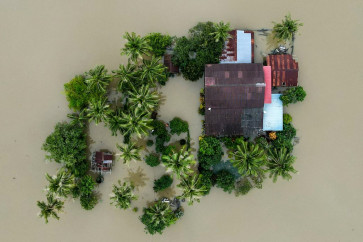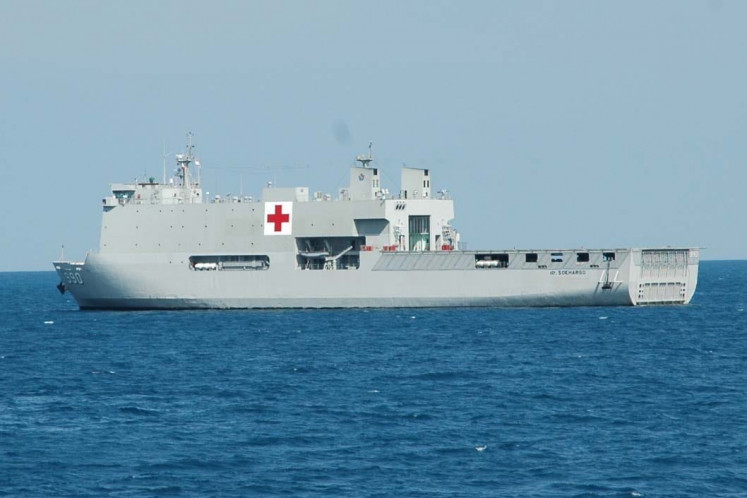Popular Reads
Top Results
Can't find what you're looking for?
View all search resultsPopular Reads
Top Results
Can't find what you're looking for?
View all search resultsHundreds of villagers flee Mount Merapi eruptions
Terror from above: Mount Merapi spews volcanic material as it erupts as seen from Pakem near Yogyakarta early Monday
Change text size
Gift Premium Articles
to Anyone
T
span class="caption">Terror from above: Mount Merapi spews volcanic material as it erupts as seen from Pakem near Yogyakarta early Monday. Two volcanoes, Merapi and Mount Sinabung in North Sumatra, erupted Monday, prompting warnings for flights and evacuation preparations. AP/Slamet Riyadi
Massive rumbling from Mount Merapi on Monday morning caused panic among hundreds of residents living on the slopes of the volcano who promptly headed to evacuation assembly points.
The volcano, located on the border between Yogyakarta and Central Java provinces, erupted at around 4:53 a.m., spewing volcanic materials 2 kilometers into the air and covering areas east of the volcano with dust and ash.
'Mount Merapi experienced a phreatic eruption. Its status remains normal due to a lack of activity,' Yogyakarta's Geological Disaster Technology Development and Research Agency (BPPTKG) head, Subandrio, told The Jakarta Post on Monday.
He explained that phreatic eruptions were steam explosions caused by the vaporization of water usually due to heat generated by proximity to a body of magma, thus forming an accumulation of high-pressured gas which triggered an eruption.
Heavy rain fell over the Yogyakarta region from Sunday noon until the evening. 'On Monday at 4:52 a.m. before the eruption, BPPTKG detected an earthquake in Ciamis, West Java, at a magnitude of 4.7 on the Richter scale. The tectonic quake is believed to have shaken the magma chamber of Mount Merapi causing it to release gas from below,' said Subandrio.
He added that the phreatic eruption had caused volcanic ash to scatter over a radius of 60 kilometers east of the 2,900-meter high mountain, covering areas around Boyolali regency. 'Residents living around Mount Merapi were at one point alarmed due to the heavy rumbling,' said Subandrio.
The Volcanology and Geological Disaster Mitigation Center (PVMBG) head M. Hendrasto said that people were prohibited from carrying out any activities within a 1-kilometer radius.
Separately, National Disaster Mitigation Agency (BNPB) spokesman Sutopo Purwo Nugroho, in a press release said the phreatic eruption on Monday morning was similar to one on July 22. 'But today's was more powerful than the July 22 eruption,' said Sutopo.
He added that after the eruption, 600 families living in Kalitengah Lor, Kalitengah Kidul and Srune hamlets, in Glagaharjo village, Sleman regency, Yogyakarta, immediately gathered at their respective assembly points to be evacuated.
Yogyakarta BPBD member Pristiawan said villagers in Turgo village, Turi district, Sleman, located on the western flank of Mount Merapi, also fled their homes, but they returned home a few hours later as the situation returned to normal.
The volcanic ash also affected residents in nearby towns. In Surakarta, Central Java, residents were shocked by the sight of volcanic ash covering streets, gardens and roofs. The ash rain continued until around 10 a.m. on Monday.
Surowedanan village in Boyolali, located around 17 km from the peak of Mount Merapi, was also covered by volcanic ash. 'This morning, when I went out of the house at around 5 a.m., I saw ash everywhere,' said Veronica Maria Sayektiana, of Surowedanan. According to Veronica, residents were wearing masks when they ventured out of their homes as the ash was still falling along with the drizzle.
Separately, general manager of Surakarta's Adi Soemarmo Airport, Abdullah Usman, said the volcanic ash from Mount Merapi did not disrupt flights at the airport, as the weather was clear and wind velocity was normal.
However, the airport authorities remained on alert and cleaned the runway twice in the morning. Abdullah said the wind blowing from the north was quite helpful as it blew the volcanic ash away from the airport.
Mount Merapi is one of the most active volcanoes in Indonesia. In 2010 its eruptions left more than 300 people dead and forced almost 400,000 people to take refuge at 639 shelters in Klaten, Magelang, Sleman and Boyolali. The 2010 eruption also killed the volcano's spiritual keeper Ki Surakso Hargo, known as Mbah Maridjan.
In 1994, as many as 60 people were killed when the volcano erupted, while 1,300 died in a 1930 eruption.
Arya Dipa and Suherdjoko contributed to this story from Bandung and Semarang










